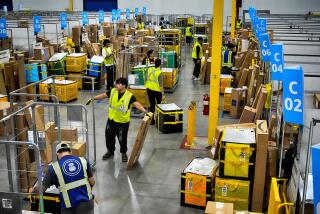Income growth slows
WASHINGTON — The first round of economic stimulus checks gave a boost to personal incomes in April but a huge question remains: Will people spend the checks quickly enough to keep the economy afloat?
The Commerce Department reported Friday that consumer spending barely budged in April, rising a tiny 0.2%, and income growth was just as weak, also increasing 0.2%.
The growth in incomes, held back by four straight months of jobs losses, would have been just 0.1% had it not been for the first wave of economic stimulus payments that the government started sending out April 28.
The effect on incomes should be even larger in the May and June reports, reflecting the bulk of the payments. The Treasury Department reported Friday that 57.4 million payments have been made totaling $50.04 billion, nearly half of the $106.7 billion that will be disbursed this year to 130 million households.
The checks are the centerpiece of a $169-billion stimulus package that Congress passed at President Bush’s urging in February with the aim of jump-starting the stalled economy.
Analysts said whether the checks keep the economy out of a recession will depend on how fast people spend the money.
“It will be impressive if consumers can manage to hold on given all the head winds they are facing,” said Mark Zandi, chief economist at Moody’s Economy.com.
“Nothing is going right. Jobs are down, the stock market is wobbly, home prices are plunging and gasoline prices are at record highs.”
All the problems have pushed consumer confidence to recessionary levels. The Reuters/University of Michigan survey of consumer sentiment dropped for a fourth straight month in May, hitting a 28-year low of 59.8, down from a reading of 62.6 in April.
The May level was the lowest since June 1980, when Jimmy Carter was in the White House and consumers were being battered by a recession and soaring gasoline prices.
The 0.2% rise in personal incomes in April was the weakest gain since a 0.2% rise in January.
Private wages and salaries declined at an annual rate of $18.2 billion in April, the biggest setback in a year.
Businesses have been cutting jobs for four straight months, with analysts forecasting a fifth month of job declines when the government reports next Friday on labor market conditions in May.
The 0.2% rise in consumer spending followed a 0.4% increase in March. Increases in recent months have largely reflected the big surge in energy costs and, to a lesser extent, higher food prices.
Excluding inflation, consumer spending would have been flat in April.
Consumer prices, measured by an inflation gauge tied to spending, rose by 0.2%, down from a 0.3% rise in March.
More to Read
Inside the business of entertainment
The Wide Shot brings you news, analysis and insights on everything from streaming wars to production — and what it all means for the future.
You may occasionally receive promotional content from the Los Angeles Times.










